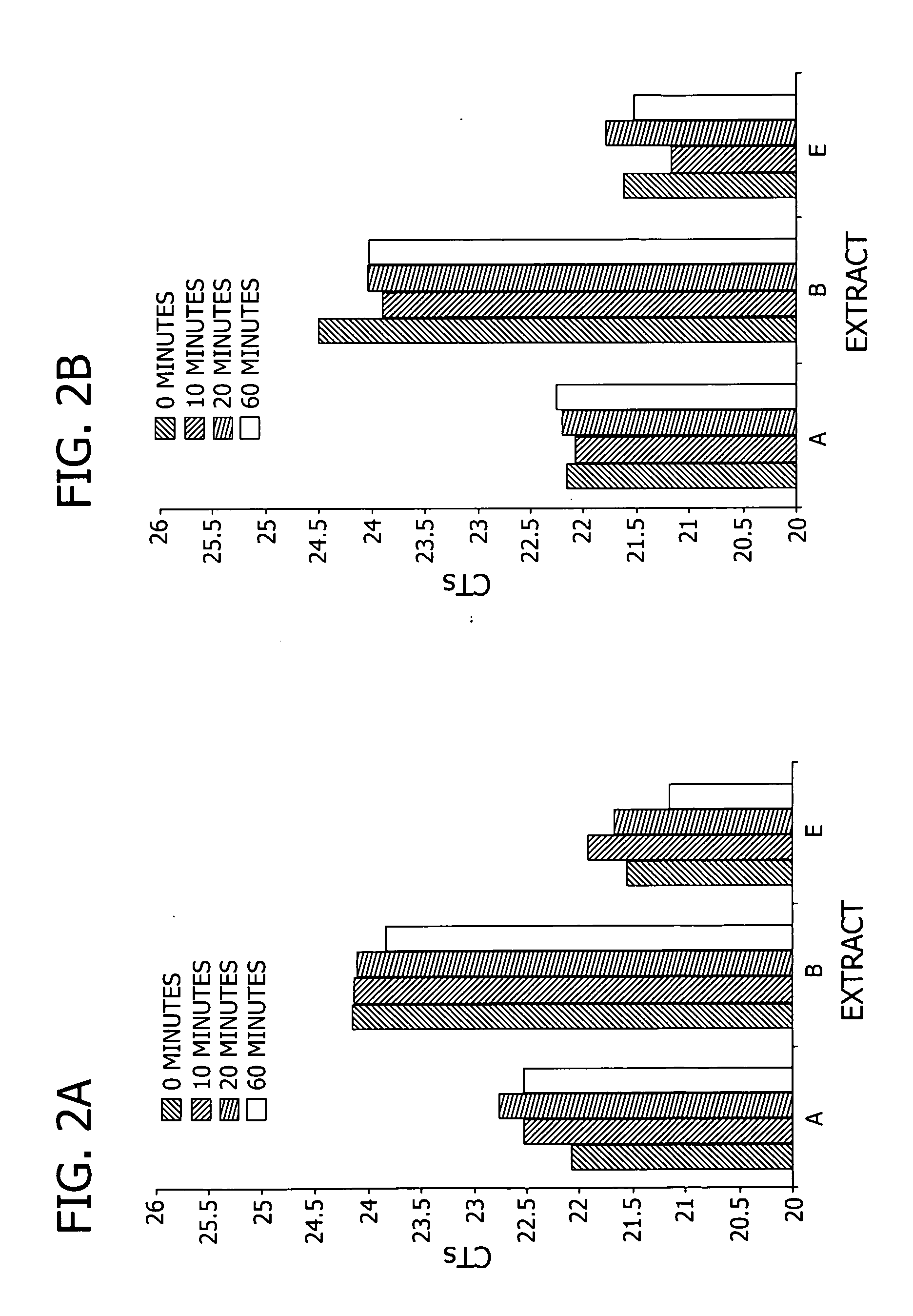Methods and composition for RNA extraction
a technology of rna and composition, applied in the field of methods and compositions for extracting rna, can solve the problems of large amount, difficult to maintain the integrity of rna in the lysate, and not typically contained in the lysate of coarse lysa
- Summary
- Abstract
- Description
- Claims
- Application Information
AI Technical Summary
Problems solved by technology
Method used
Image
Examples
example 1
Effectiveness of Various Extraction Solutions for Feleasing and Protecting mRNA for Direct use in qRT-PCR
[0103]In this example, an extraction medium of the present invention was compared to commercially available extraction compositions, and to purified RNA for effectiveness at releasing and protecting mRNA from cells for use in quantitative RT-PCR (qRT-PCR) reactions.
Materials and Methods
[0104]Unless otherwise noted, all materials were purchased from Sigma-Aldrich, Co., St. Louis, Mo.
[0105]Preparation of cells. HEK293 cells were grown in T75 cm2 flasks using standard cell culture techniques. The cells were trypsinized, washed with phosphate buffered saline (PBS), and seeded in media at a concentration of 20,000 cells / well in a 96-well tissue culture treated microtiter plate. The cells were allowed to attach to the wells overnight at 37° C. with 5% CO2 prior to aspirating media. Cell monolayers were then washed with 200 μl of PBS (Sigma catalog # D8662) pre-chilled to 2-8° C.
[0106]R...
example 2
Extraction of RNA from Cells with and without an RNase Inhibitor
[0111]In this example, RNA was extracted from cells using extraction solutions that did not contain an RNase inhibitor.
[0112]Preparation of cells. Hek293 cells were grown in T75 cm2 flasks using standard cell culture techniques. The cells were trypsinized, washed with PBS, and seeded in media at a concentration of 20,000 cells / well in 96-well tissue culture treated microtiter plate. The cells were allowed to attach to the wells overnight at 37° C. with 5% CO2 prior to aspirating media. Cell monolayers were then washed with 200 μl of PBS (Sigma catalog # D8662) pre-chilled to 2-8° C.
[0113]RNA extraction. RNA was extracted from the monolayers using Ambion's Cells-to-Signal Kit (Ambion, Inc., Austin Tex., catalog # 1726) per manufacturer's recommendations (“Cells-to-Signal” or extract “A”). Crude extracts were also prepared using extraction solutions B and E (components listed in Table 1). The crude extracts were generally...
example 3
Reproducibility of RNA Extraction
[0118]In this example, RNA extracts were prepared from multiple 96-well cultures for direct use in qRT-PCR to evaluate extraction-to-extraction variation.
Materials and Methods
[0119]Preparation of cells. THP1 cells were grown using standard cell culture techniques, harvested by centrifugation at 800×g, washed with PBS, and seeded at a concentration of 50,000 cells / well in 96-well tissue culture treated microtiter plates. Cell pellets were formed by spinning the plates at 1,200×g for 5 minutes and then aspirating the supernatant.
[0120]RNA extraction. Crude extracts were prepared by applying 100 μl of either extraction solution E (i.e., 1% triton X-100, 300 mM NaCl, 5% glycerol, and 100 mM tris-HCl, pH 8) or extraction solution E without NaCl (i.e., 1% triton X-100, 5% glycerol, and 100 mM tris-HCl, pH 8) to the pelleted THP1 cells, incubating for 10 minutes at ambient temperature, and mixing until homogenous by pipetting up and down. Twenty-two replica...
PUM
| Property | Measurement | Unit |
|---|---|---|
| Fraction | aaaaa | aaaaa |
| Percent by mass | aaaaa | aaaaa |
| Percent by mass | aaaaa | aaaaa |
Abstract
Description
Claims
Application Information
 Login to View More
Login to View More - R&D
- Intellectual Property
- Life Sciences
- Materials
- Tech Scout
- Unparalleled Data Quality
- Higher Quality Content
- 60% Fewer Hallucinations
Browse by: Latest US Patents, China's latest patents, Technical Efficacy Thesaurus, Application Domain, Technology Topic, Popular Technical Reports.
© 2025 PatSnap. All rights reserved.Legal|Privacy policy|Modern Slavery Act Transparency Statement|Sitemap|About US| Contact US: help@patsnap.com



